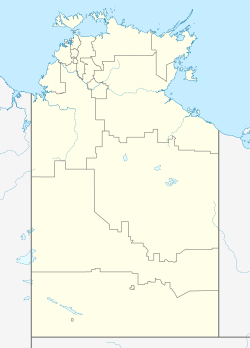Haasts Bluff
| Haasts Bluff | |||||||
|---|---|---|---|---|---|---|---|
 | |||||||
| |||||||
| |||||||
| |||||||
| |||||||
Haasts Bluff ist eine Siedlung der Luritja- und Pintupi-Aborigines, die heute von ihnen Ikuntji genannt wird. Sie liegt etwa 230 Kilometer westlich von Alice Springs im Northern Territory in den MacDonnell Ranges.
Geschichte
1872 kam Ernest Giles in diese Region und benannte sie nach dem Geologen Julius von Haast. 1905 gab es dort eine Rinderfarm und 1941 wurde diese Siedlung ein Aborigines-Reservat.
Künstlerkolonie
Als die Australier Ende der 1950er Jahre die Aborigines assimilieren wollten, wurden Aborigines des Kulturraums der Western Dessert nach Papunya deportiert. Unterschiedlichste Stämme wurden an diesem Ort zusammengeführt. Dadurch gab es Probleme im Zusammenleben, die in den frühen 1970er Jahren dazu führten, dass viele Aborigines in ihr angestammtes Land zurückkehrten. Die Pintupi und die Luritja gingen nach Haasts Bluff. Dort gründete sich 1991 das Ikuntji Women's Centre, eine von Aborigine-Frauen geführte Künstlerkolonie, in der derzeit fünfzehn Künstlerinnen arbeiten. Zu den bedeutendsten Künstlern aus Haasts Bluff gehören Marlee Naparrula, Narputta Nangala, Daisy Napaltjarri Jugadai, Alice Nampitjinpa, Eunice Napanangka Jack, Mitjili Naparrula und Long Tom Tjapanangka.[2]
Siehe auch
Quellen
- Ikuntji Art Centre in Haasts Bluff
- Landschaft um Haasts Bluff
- Haasts Bluff auf der Seite www.artkelch.de
Einzelnachweise
- ↑ Haasts Bluff. 2021 Census Quickstat. Australian Bureau of Statistics, 28. Juni 2022, abgerufen am 24. Februar 2023 (englisch).
- ↑ Archivierte Kopie ( des vom 26. Mai 2009 im Internet Archive) Info: Der Archivlink wurde automatisch eingesetzt und noch nicht geprüft. Bitte prüfe Original- und Archivlink gemäß Anleitung und entferne dann diesen Hinweis.
Auf dieser Seite verwendete Medien
Flag of Australia, when congruence with this colour chart is required (i.e. when a "less bright" version is needed).
See Flag of Australia.svg for main file information.The flag of the Northern Territory (adopted on July 1, 1978 on the first day of self-government) was designed by the Australian artist Robert Ingpen, of Drysdale Victoria, after consultation with members of the community at the invitation of the Northern Territory government. The flag incorporates the three official territorial colours of black, white and ochre and is divided into two panels, black at the hoist side taking up one third the length of the flag, with the remaining two-thirds in ochre. The black panel displays the five white stars that form the constellation of the Southern Cross, using the Victorian configuration with stars having between five and eight points. The flag also features the official Northern Territory floral emblem on the ochre panel, a stylisation of the Sturt's Desert Rose, which uses seven petals encircling a seven-pointed black star of the federation in the centre. The seven petals symbolise the six Australian states plus the Northern Territory. The Northern Territory Flag was the first official flag that did not contain the Union Jack.
Autor/Urheber: nantiriah from Adelaide, Lizenz: CC BY 2.0
Haasts Bluff, west of Alice Springs, Northern Territory
Autor/Urheber: NordNordWest, Lizenz: CC BY-SA 3.0 de
Positionskarte des Northern Territory, Australien




